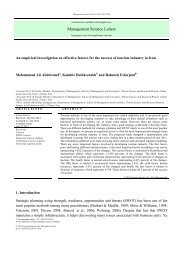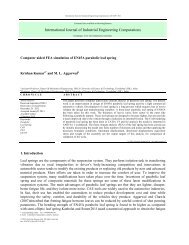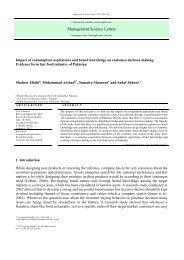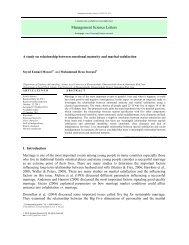Download PDF - Growing Science
Download PDF - Growing Science
Download PDF - Growing Science
You also want an ePaper? Increase the reach of your titles
YUMPU automatically turns print PDFs into web optimized ePapers that Google loves.
1512<br />
Today’s steadily growing numbers of contractor selection methodologies is the results of the<br />
awareness of the construction industry for increasing its procurement process and performance<br />
(Wong et al., 2003). There have been tremendous models developed for contractor selection<br />
decisions, which are based on the idea of decision-making process (Demirtas & Stun, 2008). Among<br />
those well-known methods, MCDM is relatively new for selection of contractors (Cheng & Li, 2004).<br />
The VIKOR method is an MCDM method for solving a discrete multicritea problem while there are<br />
conflicting criteria (Opricovic, 1998). The primary focuses of such techniques is on ranking and<br />
selecting from a set of alternatives, and determine compromise solutions for a problem with<br />
conflicting criteria, which can help the decision makers to reach a final decision. The compromise<br />
solution is a feasible solution, which makes a solution as close as possible to ideal objectives<br />
(Opricovic & Tzeng, 2004). VIKOR is based on old ideas of compromise programming (Duckstein &<br />
Opricovic, 1980; Yu, 1973). Opricovic (2007) is believed to the first person who introduced an<br />
extension of VIKOR to determine fuzzy compromise solution for MCDM problems.<br />
The fuzzy VIKOR method is developed as a fuzzy MCDM method to solve a discrete fuzzy MCDM<br />
problem with conflicting criteria and it is presented in Section 2. The background for this method,<br />
including aggregation, normalization, DM’s preference assessment, and operations on fuzzy numbers<br />
are discussed, as a study of rationality that in some way justifies the fuzzy VIKOR method and shows<br />
the position of its background in the literature on MCDM. This new method presents a contribution to<br />
the practice of MCDM.<br />
In this study, a modified fuzzy VIKOR technique is proposed to make an MCDM selection among<br />
alternative contractors. In the proposed methodology, a fuzzy analytical hierarchy process (AHP)<br />
determines the decision makers’ opinions on the relative importance of the selection criteria. In order<br />
to demonstrate the potential of this methodology, an application contractor selection in one of Iranian<br />
construction industry projects will be presented.<br />
The rest of the paper is organized as follows: In Section 2, a literature review about Methodologies<br />
and Criteria considered used is briefly given. In the third section, Current situation in Ira, In section 4,<br />
a modified fuzzy VIKOR methodology is presented. In Section 5, following the determination of the<br />
selection criteria and alternatives, the proposed methodology is applied to a selection contractor<br />
problem. Finally, in the last section, concluding remarks are given.<br />
2. Literature review<br />
2.1. Used methodologies<br />
During the past few decades, there have been different techniques proposed for contractor selection,<br />
however, many decisions end of accepting low pricing offers. For example, in Denmark a contractor<br />
used to be selected by rejecting the two highest and two lowest applicants and choosing the one,<br />
which suggests the price closest to the average (Hatush & Skitmore, 1998; Kadefors et al. 2007;<br />
Zavadaskas & Vilutiene, 2006). In other countries such as Italy, Portugal and South Korea, only the<br />
highest and the lowest applicants are discarded and the one, which is close average is chosen. In<br />
France, all applicants, which offer abnormally low prices are rejected (Hatush & Skitmore, 1998;<br />
Zavadaskas & Vilutiene, 2006). In Australia, contractor selection depends on various criteria and the<br />
process is used based on two stages: first, the contractor’s experience is assessed and then bargaining<br />
for low price happens (Kashiwhgi & Byfield, 2002).<br />
In Saudi Arabia, the lowest bidder is chosen, which is not less than 70% of the owner’s cost estimate<br />
(Hatush & Skitmore, 1998). In Turkey, a two-stage procedure is implemented, however, the lowest<br />
price says the last word (Topcu, 2004; Wong et al., 2003; Zavadaskas & Vilutiene, 2006). In Canada<br />
and the USA, particularly in the public sector, the ‘‘lowest bidder” is the method of contractor<br />
selection, but a bid bond in an amount equal to 10% of the bid price also needs to be provided








